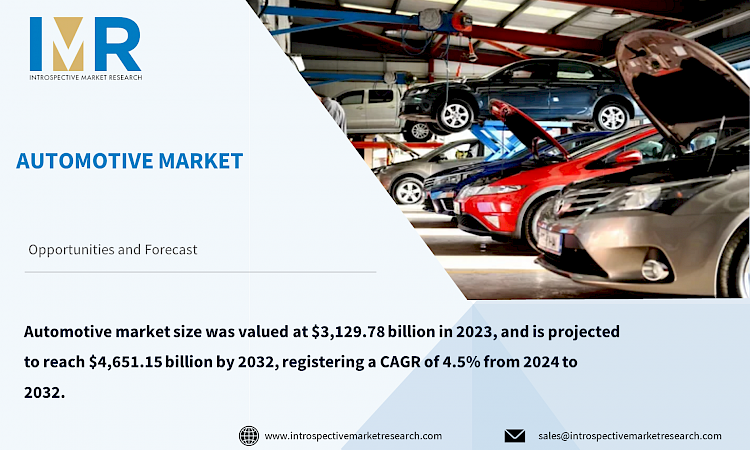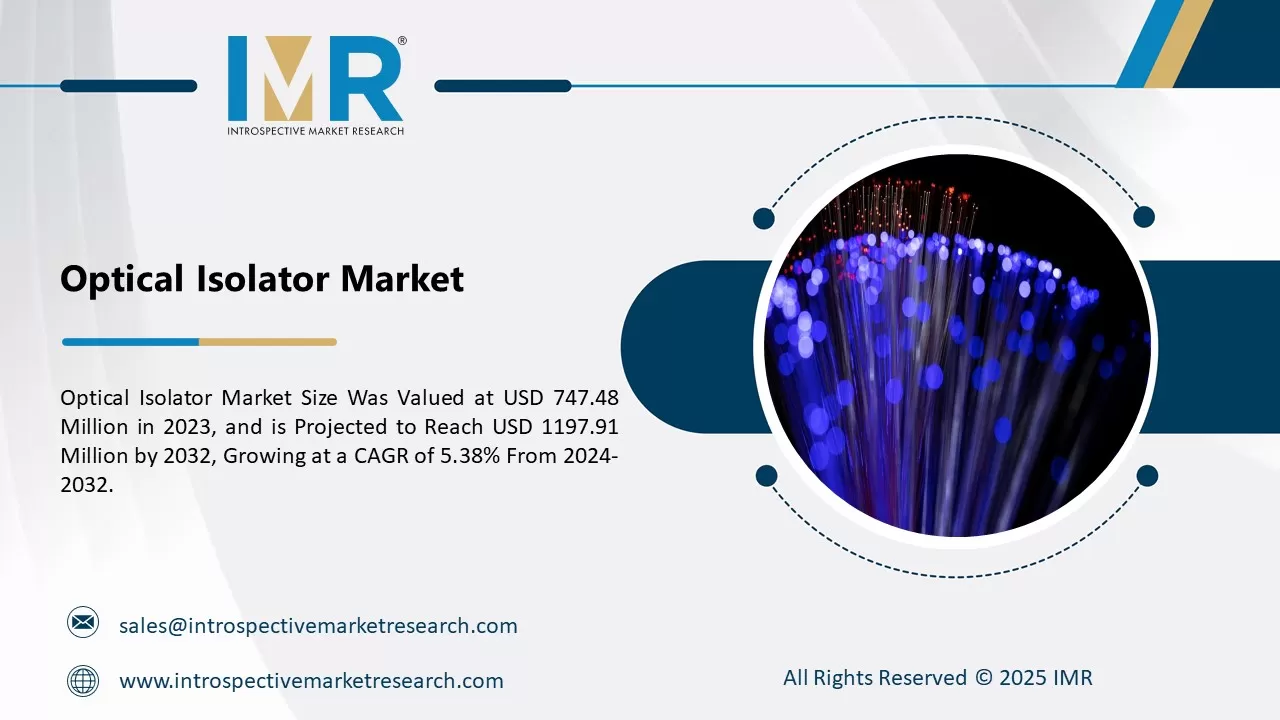Automotive Market Synopsis
According to a new report published by Introspective Market Research, titled, ?Automotive Market by Type, Vehicle Type, Application: Global Opportunity Analysis and Industry Forecast, 2024?2032,?
Global automotive market size was valued at $3,129.78 billion in 2023, and is projected to reach $4,651.15 billion by 2032, registering a CAGR of 4.5% from 2024 to 2032.
The automotive industry encompasses a diverse array of companies and organizations involved in the entire lifecycle of vehicles, including design, development, manufacturing, marketing, selling, and repair. It features various types of vehicles such as passenger cars, light commercial vehicles, trucks, buses, and motorcycles. Modern vehicles are equipped with advanced safety features like ADAS (Advanced Driver Assistance Systems), anti-lock brake systems, and numerous sensors integrated into central computer systems. The engines in these vehicles are not only more powerful but also smarter compared to older models, thanks to technological advancements.
Machine Learning (ML) and Artificial Intelligence (AI) are set to revolutionize the automotive industry by facilitating the development of self-driving cars, enhancing advanced driver assistance systems, and introducing personalized assistance features. As global population growth continues, the automotive market has the potential to expand its customer base. The rising demand for vehicles is driven by urbanization, improving economic conditions, and a heightened need for personal mobility. Furthermore, consumer preferences are increasingly leaning towards vehicles with advanced safety features, connectivity, and environmental sustainability, pushing the industry to meet strict emission standards and embrace a future of greener, more technologically advanced automobiles.
The automotive industry is experiencing a significant surge in demand for advanced safety features as consumers prioritize convenience, safety, and comfort in their vehicles. From power steering systems to anti-lock braking systems, there's a growing appetite for innovations like steering-mounted controls, heads-up displays, and advanced infotainment systems. This trend is driving the integration of electronic components and software content in vehicles worldwide, leading to cutting-edge technology-based features such as automatic high-beam headlights, blind-spot warning systems, and lane-departure warning systems. These advancements not only enhance the driving experience but also contribute to the overall growth of the automotive market.
Simultaneously, the industry is undergoing a transformative shift with the Electric Vehicle (EV) Revolution gaining momentum. Automotive manufacturers are introducing a wide range of electric vehicle models, spanning various segments from compact cars to SUVs and trucks. This revolution is fueled by developments in battery technology, charging infrastructure, and energy management systems, enabling significant investments in research and development. Collaborations with energy companies and tech innovators are pivotal for manufacturers seeking to position themselves at the forefront of sustainability. The EV Revolution presents a strategic opportunity for automotive players to differentiate their brands, appeal to consumers valuing innovation and lower operating costs, and contribute to a more sustainable and technologically advanced automotive future.
Global Automotive Market, Segmentation
The Automotive market is segmented based on type, vehicle type, application, and region.
Type:
The global automotive market is largely dominated by the Passenger Wheelers segment, reflecting the substantial demand for personal transportation solutions worldwide. With a diverse range of vehicles catering to individual mobility needs, including sedans, SUVs, hatchbacks, and luxury cars, this segment holds a significant share in terms of sales and revenue. Consumer preferences for comfort, style, and performance continue to drive growth in the Passenger Wheelers segment, shaping the trajectory of the automotive industry toward meeting evolving market demands.
Vehicle Type:
The Electric Vehicle (EV) segment, comprising Battery Electric Vehicles (BEVs) and Hybrid Electric Vehicles (HEVs), is witnessing significant investment in research and development aimed at enhancing efficiency, extending range, and strengthening charging infrastructure. This focus not only reduces carbon footprints and operational costs but also reshapes the automotive market as consumers increasingly prioritize cleaner and greener transportation alternatives. As a result, the accelerated adoption of EVs is expected, marking a pivotal shift in the industry towards sustainability and technological advancement.
Region:
The Asia Pacific region is poised to dominate the automotive market over the forecast period, driven by factors such as robust economic growth, rapid urbanization, and an expanding middle class. Government initiatives and policies, coupled with a commitment to innovation in electric vehicle development, are propelling the industry forward. With a focus on diverse electric vehicle models and supportive measures like incentives and developing charging infrastructure, the region is expected to significantly shape the automotive industry's future, emphasizing environmental consciousness, technological progress, and regulatory support.
Some of the leading Automotive market players are
- Tesla (U.S.)
- Ford (U.S.)
- General Motors (U.S.)
- Mercedes-Benz (Germany)
- Volkswagen (Germany)
- BMW (Germany)
- Audi (Germany)
- Ferrari (Italy)
- Porsche (Germany)
- Stellantis (Netherlands)
- Renault (France)
- Toyota (Japan)
- Honda (Japan)
- Nissan (Japan)
- Suzuki Motor (Japan)
- Airways (China)
- Mitsubishi Motors Corporation (Japan)
- Hyundai (South Korea)
- Kia (South Korea)
- Denso Corporation (Japan), and other major players.
Key Industry Developments
- In August 2023, Stellantis made a significant investment exceeding $100 million to advance the progress of a geothermal lithium project in California. This initiative aims to accelerate the decarbonization of supply chains for battery electric vehicles, marking a noteworthy milestone for the company. The substantial investment in this Clean Technology Resources (CTR) project underscores Stellantis' commitment to fostering sustainable practices in the production of electric vehicle batteries.
- In June 2023, Volkswagen announced plans to expand its lineup in China through partnerships with Xpeng and SAIC. Strengthening its presence in the Chinese market, Volkswagen initiated a $700 million investment partnership with Xpeng and further collaboration with SAIC and Audi. The joint efforts between Volkswagen and SAIC, a leading Chinese automaker, include the development of two new Volkswagen brand models based on the innovative Modular Electric Drive Matrix (MEB) platform.
Key Findings of the Study
- The global automotive market, valued at $3,129.78 billion in 2023, is projected to decline to $2,651.15 billion by 2032, with a CAGR of 4.5% from 2024 to 2032.
- The Passenger Wheelers segment dominates the market, driven by high demand for personal transportation solutions and consumer preferences for comfort, style, and performance.
- The Electric Vehicle (EV) segment, including Battery Electric Vehicles (BEVs) and Hybrid Electric Vehicles (HEVs), is seeing substantial R&D investment, enhancing efficiency, range, and charging infrastructure, and accelerating the shift towards cleaner transportation alternatives.
- Advanced safety features such as ADAS, anti-lock braking systems, and innovative technologies like heads-up displays and blind-spot warnings are significantly driving the automotive market's growth.
- The Asia Pacific region is expected to lead the automotive market due to robust economic growth, urbanization, and supportive government initiatives, emphasizing the development of electric vehicles and charging infrastructure.





